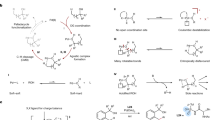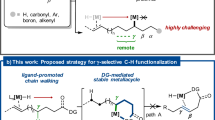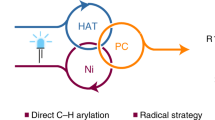Abstract
C–H activation reactions enable chemists to unveil new retrosynthetic disconnections and streamline conventional synthetic approaches. A long-standing challenge in C–H activation is the inability to distinguish electronically and sterically similar C–H bonds. Although numerous synergistic combinations of transition-metal complexes and chelating directing groups have been utilized to distinguish C–H bonds, undirected regioselective C–H functionalization strategies remain elusive. Here we report a regioselective C–H activation/amination reaction of various unsymmetrical dialkyl-substituted alkenes. The regioselectivity of C–H activation is correlated to the electronic properties of allylic C–H bonds indicated by the corresponding 1JCH coupling constants. A linear relationship between the difference in the 1JCH coupling constants of the two competing allylic C–H bonds (Δ1JCH) and the C–H activation barriers (ΔΔG‡) has also been determined.

This is a preview of subscription content, access via your institution
Access options
Access Nature and 54 other Nature Portfolio journals
Get Nature+, our best-value online-access subscription
$29.99 / 30 days
cancel any time
Subscribe to this journal
Receive 12 print issues and online access
$259.00 per year
only $21.58 per issue
Buy this article
- Purchase on Springer Link
- Instant access to full article PDF
Prices may be subject to local taxes which are calculated during checkout



Similar content being viewed by others
Data availability
All data generated or analysed during this study are included in this published article and its Supplementary Information.
References
McMurray, L., O’Hara, F. & Gaunt, M. J. Recent developments in natural product synthesis using metal-catalysed C–H bond functionalisation. Chem. Soc. Rev. 40, 1885–1898 (2011).
Gutekunst, W. R. & Baran, P. S. C–H functionalization logic in total synthesis. Chem. Soc. Rev. 40, 1976–1991 (2011).
Yamaguchi, J., Yamaguchi, A. D. & Itami, K. C–H bond functionalization: emerging synthetic tools for natural products and pharmaceuticals. Angew. Chem. Int. Ed. 51, 8960–9009 (2012).
Cernak, T., Dykstra, K. D., Tyagarajan, S., Vachal, P. & Krska, S. W. The medicinal chemist’s toolbox for late stage functionalization of drug-like molecules. Chem. Soc. Rev. 45, 546–576 (2016).
Colby, D. A., Bergman, R. G. & Ellman, J. A. Rhodium-catalyzed C–C bond formation via heteroatom-directed C–H bond activation. Chem. Rev. 110, 624–655 (2010).
Lyons, T. W. & Sanford, M. S. Palladium-catalyzed ligand-directed C–H functionalization reactions. Chem. Rev. 110, 1147–1169 (2010).
He, J., Wasa, M., Chan, K. S. L., Shao, Q. & Yu, J. Q. Palladium-catalyzed transformations of alkyl C–H bonds. Chem. Rev. 117, 8754–8786 (2017).
Sambiagio, C. et al. A comprehensive overview of directing groups applied in metal-catalysed C–H functionalisation chemistry. Chem. Soc. Rev. 47, 6603–6743 (2018).
Newhouse, T. & Baran, P. S. If C–H bonds could talk: selective C–H bond oxidation. Angew. Chem. Int. Ed. 50, 3362–3374 (2011).
Hartwig, J. F. & Larsen, M. A. Undirected, homogeneous C–H bond functionalization: challenges and opportunities. ACS Cent. Sci. 2, 281–292 (2016).
Xue, X. S., Ji, P., Zhou, B. & Cheng, J. P. The essential role of bond energetics in C–H activation/functionalization. Chem. Rev. 117, 8622–8648 (2017).
Romero, N. A., Margrey, K. A., Tay, N. E. & Nicewicz, D. A. Site-selective arene C–H amination via photoredox catalysis. Science 349, 1326–1330 (2015).
Paudyal, M. P. et al. Dirhodium-catalyzed C–H arene amination using hydroxylamines. Science 353, 1144–1147 (2016).
Berger, F. et al. Site-selective and versatile aromatic C–H functionalization by thianthrenation. Nature 567, 223–228 (2019).
Chen, M. S. & White, M. C. Combined effects on selectivity in Fe-catalyzed methylene oxidation. Science 327, 566–571 (2010).
Schmidt, V. A., Quinn, R. K., Bruscoe, A. T. & Alexanian, E. J. Site-selective aliphatic C–H bromination using N-bromoamides and visible light. J. Am. Chem. Soc. 136, 14389–14392 (2014).
Sharma, A. & Hartwig, J. F. Metal-catalysed azidation of tertiary C–H bonds suitable for late-stage functionalization. Nature 517, 600–604 (2015).
Eames, J. & Watkinson, M. Catalytic allylic oxidation of alkenes using an asymmetric Kharasch–Sosnovsky reaction. Angew. Chem. Int. Ed. 40, 3567–3571 (2001).
Sharma, A. & Hartwig, J. F. Enantioselective functionalization of allylic C–H bonds following a strategy of functionalization and diversification. J. Am. Chem. Soc. 135, 17983–17989 (2013).
Cuthbertson, J. D. & MacMillan, D. W. C. The direct arylation of allylic sp3 C–H bonds via organic and photoredox catalysis. Nature 519, 74–77 (2015).
Liu, W., Ali, S. Z., Ammann, S. E. & White, M. C. Asymmetric allylic C–H alkylation via palladium(ii)/cis-ArSOX catalysis. J. Am. Chem. Soc. 140, 10658–10662 (2018).
Li, J. et al. Site-specific allylic C–H bond functionalization with a copper-bound N-centred radical. Nature 574, 516–521 (2019).
Reed, S. A. & White, M. C. Catalytic intermolecular linear allylic C–H amination via heterobimetallic catalysis. J. Am. Chem. Soc. 130, 3316–3318 (2008).
Liu, G., Yin, G. & Wu, L. Palladium-catalyzed intermolecular aerobic oxidative amination of terminal alkenes: efficient synthesis of linear allylamine derivatives. Angew. Chem. Int. Ed. 47, 4733–4736 (2008).
Bao, H. & Tambar, U. K. Catalytic enantioselective allylic amination of unactivated terminal olefins via an ene reaction/[2,3]-rearrangement. J. Am. Chem. Soc. 134, 18495–18498 (2012).
Burman, J. S. & Blakey, S. B. Regioselective intermolecular allylic C–H amination of disubstituted olefins via rhodium/π-allyl intermediates. Angew. Chem. Int. Ed. 56, 13666–13669 (2017).
Lei, H. & Rovis, T. Ir-catalyzed intermolecular branch-selective allylic C–H amidation of unactivated terminal olefins. J. Am. Chem. Soc. 141, 2268–2273 (2019).
Knecht, T., Mondal, S., Ye, J. H., Das, M. & Glorius, F. Intermolecular, branch-selective, and redox-neutral Cp*IrIII-catalyzed allylic C–H amidation. Angew. Chem. Int. Ed. 58, 7117–7121 (2019).
Burman, J. S., Harris, R. J., Farr, C. M. B., Bacsa, J. & Blakey, S. B. Rh(iii) and Ir(iii)Cp* complexes provide complementary regioselectivity profiles in intermolecular allylic C–H amidation reactions. ACS Catal. 9, 5474–5479 (2019).
Liang, C. et al. Toward a synthetically useful stereoselective C–H amination of hydrocarbons. J. Am. Chem. Soc. 130, 343–350 (2008).
Lescot, C., Darses, B., Collet, F., Retailleau, P. & Dauban, P. Intermolecular C–H amination of complex molecules: insights into the factors governing the selectivity. J. Org. Chem. 77, 7232–7240 (2012).
Bayeh, L., Le, P. Q. & Tambar, U. K. Catalytic allylic oxidation of internal alkenes to a multifunctional chiral building block. Nature 547, 196–200 (2017).
Nishioka, Y., Uchida, T. & Katsuki, T. Enantio- and regioselective intermolecular benzylic and allylic C–H bond amination. Angew. Chem. Int. Ed. 52, 1739–1742 (2013).
Szabó, K. J. Nature of the interaction between β-substituents and the allyl moiety in (η3-allyl)palladium complexes. Chem. Soc. Rev. 30, 136–143 (2001).
Piou, T. et al. Correlating reactivity and selectivity to cyclopentadienyl ligand properties in Rh(iii)-catalyzed C–H activation reactions: an experimental and computational study. J. Am. Chem. Soc. 139, 1296–1310 (2017).
Piou, T. & Rovis, T. Electronic and steric tuning of a prototypical piano stool complex: Rh(iii) catalysis for C–H functionalization. Acc. Chem. Res. 51, 170–180 (2018).
Hansen, P. E. Carbon–hydrogen spin–spin coupling constants. Prog. Nucl. Magn. Reson. Spectrosc. 14, 175–295 (1981).
Yoder, C. H., Tuck, R. H. & Hess, R. E. Nuclear magnetic resonance studies of the bonding in aromatic systems. Correlation of Hammett sigma constants with methyl 13C–H coupling constants and chemical shifts. J. Am. Chem. Soc. 91, 539–543 (1969).
Acknowledgements
We thank NIGMS (GM80442) for support. We thank J. Decatur for assistance with determining 1JCH coupling constants.
Author information
Authors and Affiliations
Contributions
H.L. and T.R. conceived and initiated the study. H.L. designed and conducted the experiments. H.L. and T.R. co-wrote the manuscript.
Corresponding author
Ethics declarations
Competing interests
The authors declare no competing interests.
Additional information
Publisher’s note Springer Nature remains neutral with regard to jurisdictional claims in published maps and institutional affiliations.
Supplementary information
Supplementary Information
Experimental procedures, characterization data and mechanistic studies, Supplementary Fig. 1 and Tables 1 and 2.
Rights and permissions
About this article
Cite this article
Lei, H., Rovis, T. A site-selective amination catalyst discriminates between nearly identical C–H bonds of unsymmetrical disubstituted alkenes. Nat. Chem. 12, 725–731 (2020). https://doi.org/10.1038/s41557-020-0470-z
Received:
Accepted:
Published:
Issue Date:
DOI: https://doi.org/10.1038/s41557-020-0470-z
This article is cited by
-
Metalloradical approach for concurrent control in intermolecular radical allylic C−H amination
Nature Chemistry (2023)
-
Allylic C(sp3)–H arylation of olefins via ternary catalysis
Nature Synthesis (2022)
-
Site-selective amination towards tertiary aliphatic allylamines
Nature Catalysis (2022)
-
Efficient Lewis acid catalysis of an abiological reaction in a de novo protein scaffold
Nature Chemistry (2021)



